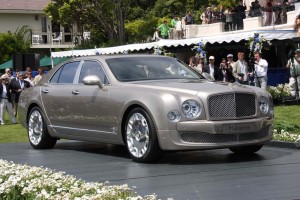
The Bentley Mulsanne makes its formal debut at the 59th annual Pebble Beach Concours d'Elegance.
For most of its long and storied history, the Pebble Beach Concours d’Elegance has provided a rearview mirror on the automotive past, but this year, the show is serving up a look towards the future for one of the industry’s most exclusive and celebrated marques, Bentley Motors.
The British brand pulled off a first-of-its-kind coup, this year, convincing Concours organizers to permit, for the first time in its 59-year history, the debut of an all-new automobile. More specifically, it’s the public unveiling of the Mulsanne, the completely redesigned flagship for Bentley, which is also the “honored marque” at the 59th Concours d’Elegance.
Expected to carry a price tag in excess of $400,000, the Mulsanne is “miles away” from the outgoing Arnage sedan, says the brand’s CEO Franz-Josef Paefgen, an aging behemoth that has served as the pinnacle of Bentley’s line-up for more than a decade. For the British brand’s aficionados, that’s an inside joke referencing the fact that that both Arnage and Mulsanne are noted points on the legendary Le Mans race track where Bentley first established itself more than 80 years ago.
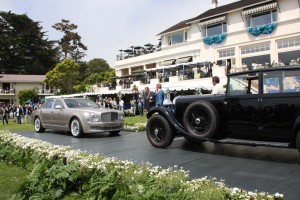
Old and new, the Mulsanne comes nose-to-nose with W.O. Bentley's own 8-liter saloon car on the stage at Pebble.
The gap between old car and new is more than it might first seem and represents more than just a redesign. The outgoing Arnage was originally developed before Bentley parted ways with its long-time sibling, Rolls-Royce Motor Cars. The former became a subsidiary of Volkswagen AG, its long-term partner, now rival, is now a part of BMW AG.
Prior to the split, Bentley effectively had to settle for Rolls’s hand-me-downs, though with the split, it has revived its sporting heritage, buoyed by a successful return to the Le Mans circuit, earlier in the decade. But where Rolls pushed out an all-new Phantom, several years ago, to replace its big sedan, Bentley initially focused on the lower end of its range, with the all-new Continental line.
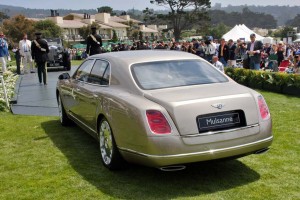
There's a subtle familial resemblance - note the Continental-derived taillights - but the 2011 Bentley Mulsanne is ground-up new.
Now it is getting set to take on Rolls directly, with the Mulsanne, which will be positioned as a more sporty model than Phantom and, arguably, as the more attractive of the two.
“It feels strange to be here as a German introducing a new flagship British car to the public in America,” joked Paefgen.
Indeed, the new Mulsanne is as close as the company has come to building a truly British automobile. The Continental project relied heavily on Bentley’s parent, VW, with much of the R&D done in Germany. On Mulsanne, the key development effort was led by Crewe, the British marque’s headquarters – though there’s little chance the project could have been pulled off without Volkswagen’s vast resources.
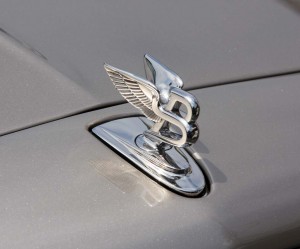
One thing never changes: the Bentley Flying "B" hood ornament adorns the 2011 Mulsanne.
In fact, there were plenty of questions raised, when the project began, whether Bentley could afford to make it happen, even with VW’s support. “We had no money and no plan to do a replacement” for Arnage, recalls Paefgen, who adds that the original intent was to do it as cheaply as possible.”
Over the next couple years, however, the effort became more intense and more expansive, and the mid-decade success of the Continental line-up helped free up the money Bentley needed. In the end, rather than simply updating the Arnage platform, the maker was able to complete a totally unique car from the ground up.
“We had just five parts left over” and reused from the old Arnage, says Paefgan, “which I could take home in a briefcase.” Adds Bentley’s engineering director, Uli Eichorn, the only bits carried over were the Bentley badges and a couple fasteners.
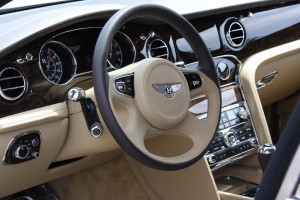
The interior of the 2011 Bentley Mulsanne continues to be swathed in leather and hand-finished wood, but the steering wheel-mounted paddle shifters hint at the new technology that will debut on the big saloon car.
Beyond that, Bentley is being a bit coy when it comes to the technical details of the new Mulsanne. Eichorn tells TheDetroitBureau.com that the sedan is “a bit” bigger than the old Arnage, but “also a bit lighter,” perhaps 100 pounds or so, according to other sources. That underscores the use of lightweight aluminum and composite body panels, though the overall chassis and body remain steel.
The all-new 6.75-liter engine is also markedly lighter than the old powertrain, and uses such tricks as Displacement-on-Demand, where half the cylinders are deactivated when cruising, and power demands are low. In line with Bentley’s pledge to reduce CO2 output, or at least get credits to make it appear they are, meanwhile, insiders suggest a flex-fuel version will follow in the next year or two. Overall, it is expected that the Mulsanne will achieve at least a 10% improvement in fuel economy from the current car, even though it will also deliver more horsepower and increased torque.
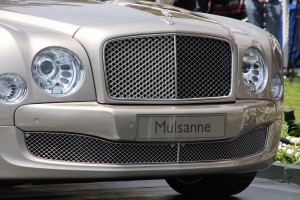
The mesh grille is familiar, yet modern. The headlights also aim for a "heritage" look, though they combine modern halogen and LED technology.
Like other ultra-luxury brands, Bentley makes extensive use of birdseye maple and other elegant woods, as well as top-line leathers. The cabin continues in that tradition, with a flourish. The wood detailing on the new car actually wraps around the rear seats. Unlike the traditional car in this segment, however, the Mulsanne is designed to be a driver’s car as well as something an owner might hand over to a chauffeur. There are steering wheel-mounted paddle shifters, for example, to run the car through its gears during hard driving.
The speedometer, in fact, goes up to 200 mph, and it is expected that the Mulsanne will be able to well exceed 150 mph in actual driving, a significant performance for a product approaching three tons in weight.
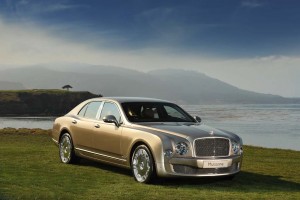
Bentley will provide more insight at the Frankfurt Motor Show, next month, though the 2011 Mulsanne won't hit showrooms until early in 2010.
At the upcoming Frankfurt Motor Show, Bentley is expected to provide more details about the car’s technology, though Eichorn and others hint the sedan will be loaded with the latest in electronics intended to enhance not only performance but safety and comfort. Four-mode adjustable suspension damping is apparently one of the features and Bentley is likely to offer a self-parking feature, as well. Staying on top will be a significant challenge, however, considering the way even economy and mainstream cars – like the Ford Taurus – are loading up on digital technology.
Part of the challenge Bentley faced with Mulsanne was not just modernizing the car but adding a sense of heritage and gravitas. The maker wanted to avoid some of the controversy that surrounded the launch of the Rolls Phantom.
But Eichorn stresses that it was critical that each design element, such as the crease flowing from the roof into the rear fenders, actually have a function. Along with a subtle flip of the trunk lid, the lines improve aerodynamics, especially at extreme speeds. That improves stability, among other things.
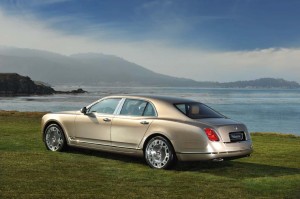
The 2011 Bentley Mulsanne is "a bit larger but also a bit lighter" than the old Arnage, says the automaker's engineering chief, Uli Eichorn.
Bentley is hoping the new Arnage will significantly increase its presence in the ultra-luxury segment, and a source suggests it could be looking at sales of up to 1000 vehicles annually, which would pose a distinct challenge to Rolls-Royce. But the BMW subsidiary is fighting back. It is getting ready to roll out its all-new Ghost, which will come in, at around $250,000, just slightly above the Bentley Continental line-up.
Of course, both makers have other challenges to face. The current economic recession has taken an unexpected toll on the luxury market, including the normally immune ultra-luxury segment. But Paefgen says he is hoping that Mulsanne will hit the market, in mid-2010, just as the global auto market recovers. There’s no question, the new car is generating plenty of interest.
It was surrounded by journalists at the Pebble Beach preview, and at a private party, the night before, scores of potential buyers gave Mulsanne an enthusiastic welcoming when the covers were lifted.
“It does what it needs to do,” said Bruce McCaw, the Seattle entrepreneur who also has one of the largest collections of classic Bentleys in the world. “This finally brings them into this century.”
